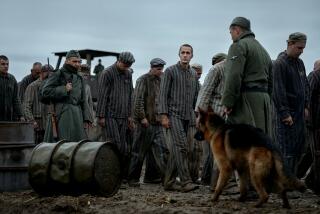TV AND THE GULF WAR : New World Order of TV Struggles to Show ‘Real War’
- Share via
Dan Rather felt it, though he couldn’t see it.
The ground battle, he somberly told CBS viewers Sunday morning, is “real war, real pain, real bleeding, real death.” Later, with more than a dash of hyperbole, he added about reported chaos in Iraqi military ranks: “Perhaps not since the Greeks retreated from Babylon has there been such a disorderly retreat.”
Descriptive images.
But not that you--or Rather himself, reporting live from his customary anchor position in Dhahran, Saudi Arabia--could view many of them on the screen. That was because the ground combat that Iraqi President Saddam Hussein predicted would be “the mother of all battles” had only coolly embraced television.
HAL, the controlling computer in “2001: A Space Odyssey,” dramatized how technology inevitably moves faster than our ability to control it. We had our own taste of technology run amok early in the Persian Gulf War when all the networks used their capacity for instant coverage too often and too impulsively, cluttering the airwaves with live pictures of Scuds, gas masks and in some cases panicky reporters.
But that was then.
As land hostilities unfolded through the weekend, it was obvious that TV’s HAL had been unplugged and the network technology no longer was in control. Now the human factor prevailed, not the networks themselves, but the military and Pentagon, tightly limiting access in the desert and the flow of information.
The big question is whether the military HAL is more trustworthy than the other one. Unlikely. We now know just how naive were those early forecasts of TV shocking America--and perhaps even influencing public opinion against the war--with live, gory pictures of troops being killed and wounded in combat. First, early reports have indicated relatively light U.S. casualties. Second, no live reporting from the field of combat.
Almost none.
Few media voices reached us on TV independent of the relatively sanitized pool coverage that began showing up late in the morning. One was CBS correspondent Bob McKeon, who had begun relaying live audio reports from the front near the Saudi-Kuwaiti border as early as Saturday night.
The first non-pool pictures in the field to date--from an ABC crew led by correspondent Forrest Sawyer--were aired early Sunday. The ABC people, who had struck out on their own, were traveling with Arab allied forces.
There was Sawyer, looking tired and haggard in his khaki jacket and camouflage fatigue pants, speaking live from near the border, the portable satellite dish visible over his shoulder, a symbol of TV’s new world order of instant reporting.
Sawyer’s stand-up was interrupted. “We’re being told we simply have to move out of the way,” he told Peter Jennings. Then to a Saudi tanker: “We’re moving! We’re moving!”
“Can you get a picture of the tank?” Jennings asked. And magically, the tank appeared on the screen.
Nevertheless, the TV’s new world order has become sand-logged in the desert. That Sawyer and his colleagues were even there, speaking live and unencumbered by pool restrictions, was refreshing and made his report seem more significant than it was.
Perhaps to rebut Iraqi radio boasts of combat success against allied forces, as Sunday wore on, snippets of pool videotape from the field were released and trickled onto the screen by CNN and the other networks:
Saudi tanks moved toward Kuwait . . . Saudi troops rounded up Iraqi prisoners . . . The battleship Missouri lobbed shells on Kuwait . . . U.S. Marines fired on Kuwait . . . Long lines of surrendering Iraqi troops were visible in the distant haze, almost ghost-like as they trudged along the horizon . . . Wounded U.S. troops were carried by stretcher into a field hospital in Saudi Arabia . . . Two Marines were interviewed after some combat.
“I just stopped shaking a few minutes ago,” one said. “I thought it would be a lot tougher,” the other Marine said, nonchalantly dabbing at his rations.
These were tastes, but small ones, with most of the real war--pain, bleeding and death that Rather described--so far left to our imagination.
More to Read
The complete guide to home viewing
Get Screen Gab for everything about the TV shows and streaming movies everyone’s talking about.
You may occasionally receive promotional content from the Los Angeles Times.






